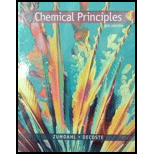
(a)
Interpretation: The reason for transfer of water from one beaker to another need to be explained.
Concept Introduction : The pressure exerted by vapor in the state of equilibrium in a system which is closed is vapor pressure. Intermolecular forces, Surface area and temperature are some factors that influence in vapor pressure. A molecule's vapor pressure varies with temperature.
(a)
Answer to Problem 1DQ
The transfer of water from one beaker to another occurs to attain equilibrium.
Explanation of Solution
If the vapour pressure of solution is less than the vapor pressure of the pure solvent, the vapor pressure required to attain equilibrium in pure solvent is more than vapor pressure needed to attain equilibrium with acid solution which is aqueous. Therefore, the emission of vapor by pure solvent lowers the vapour pressure towards equilibrium.
(b)
Interpretation: The importance of terms ‘vapor pressure’ and ‘equilibrium’ in the given phenomenon needs to be explained.
Concept Introduction : The pressure exerted by vapor in the state of equilibrium in a system which is closed is vapour pressure.
(b)
Answer to Problem 1DQ
Particular pressure in which gaseous form of a substance exists in
Explanation of Solution
The pressure exerted by vapor in the state of equilibrium in a system which is closed is vapour pressure. There is a tendency of all solids and liquids that they can change their state to gaseous state by evaporation and the gases possess a tendency to came back to their original state at particular temperature.
Particular pressure in which gaseous form of a substance exists in thermodynamic equilibrium with its solid or liquid form is the vapor pressure.
(c)
Interpretation: Whether all the water transferred to the second beaker or not needs to be determined.
Concept Introduction : Chemical equilibrium is defined as the state where both products and reactants present in quantities that do not change with time.
(c)
Answer to Problem 1DQ
Yes, the transfer of all water molecules happens.
Explanation of Solution
Yes, the transfer of all water molecules happened. When transfer of all water happens to the solution then only system can reach equilibrium vapor pressure.
(d)
Interpretation: Whether the water in the beaker containing the solute evaporates or not needs to be explained. If yes whether the rate of evaporation increasing, decreasing, or staying constant needs to be determined.
Concept Introduction: Evaporation occurs on liquid’s surface. It refers to the change of liquid state to gaseous. An evaporation rate is the rate at which a substance vaporizes.
(d)
Explanation of Solution
The decrease in count of molecules of solvent is due to the non-volatile solute dissolved in the solution. They lower the tendency of escape of solvent molecules from the solution. This is the reason of decrease of evaporation.
Want to see more full solutions like this?
Chapter 17 Solutions
CHEM.PRINC.W/OWL2+REBATE+2 SUPPL.>IP<
- Match the vapor pressure diagrams with the solute-solvent combinations and explain your answers. a. and b. and c. and d. andarrow_forwardDistinguish between dispersion methods and condensation methods for preparing colloidal systems.arrow_forwardCalculate the boiling and freezing points of water solutions that are 1.50M in the following solutes: a. KCl, a strong electrolyte b. glycerol, a nonelectrolyte c. (NH4)2SO4, strong electrolyte d. Al(NO3)3, a strong electrolytearrow_forward
 ChemistryChemistryISBN:9781305957404Author:Steven S. Zumdahl, Susan A. Zumdahl, Donald J. DeCostePublisher:Cengage Learning
ChemistryChemistryISBN:9781305957404Author:Steven S. Zumdahl, Susan A. Zumdahl, Donald J. DeCostePublisher:Cengage Learning Chemistry: An Atoms First ApproachChemistryISBN:9781305079243Author:Steven S. Zumdahl, Susan A. ZumdahlPublisher:Cengage Learning
Chemistry: An Atoms First ApproachChemistryISBN:9781305079243Author:Steven S. Zumdahl, Susan A. ZumdahlPublisher:Cengage Learning
 Physical ChemistryChemistryISBN:9781133958437Author:Ball, David W. (david Warren), BAER, TomasPublisher:Wadsworth Cengage Learning,
Physical ChemistryChemistryISBN:9781133958437Author:Ball, David W. (david Warren), BAER, TomasPublisher:Wadsworth Cengage Learning, World of Chemistry, 3rd editionChemistryISBN:9781133109655Author:Steven S. Zumdahl, Susan L. Zumdahl, Donald J. DeCostePublisher:Brooks / Cole / Cengage Learning
World of Chemistry, 3rd editionChemistryISBN:9781133109655Author:Steven S. Zumdahl, Susan L. Zumdahl, Donald J. DeCostePublisher:Brooks / Cole / Cengage Learning Principles of Modern ChemistryChemistryISBN:9781305079113Author:David W. Oxtoby, H. Pat Gillis, Laurie J. ButlerPublisher:Cengage Learning
Principles of Modern ChemistryChemistryISBN:9781305079113Author:David W. Oxtoby, H. Pat Gillis, Laurie J. ButlerPublisher:Cengage Learning





